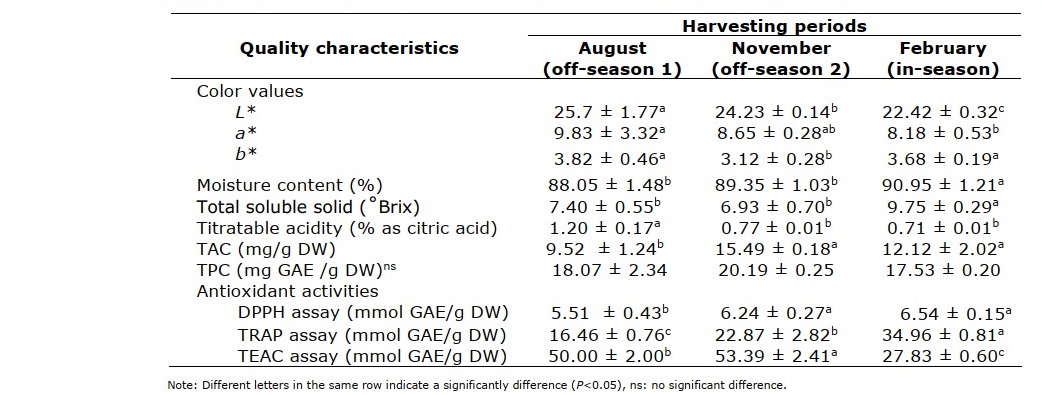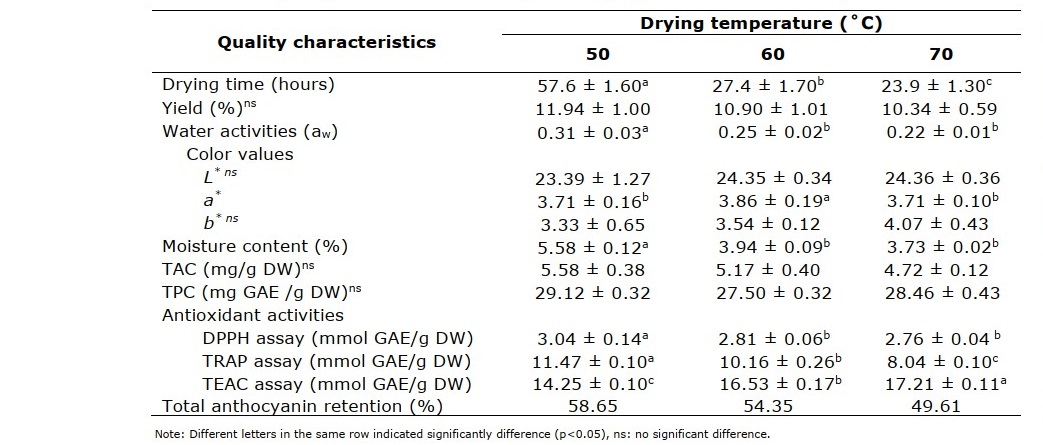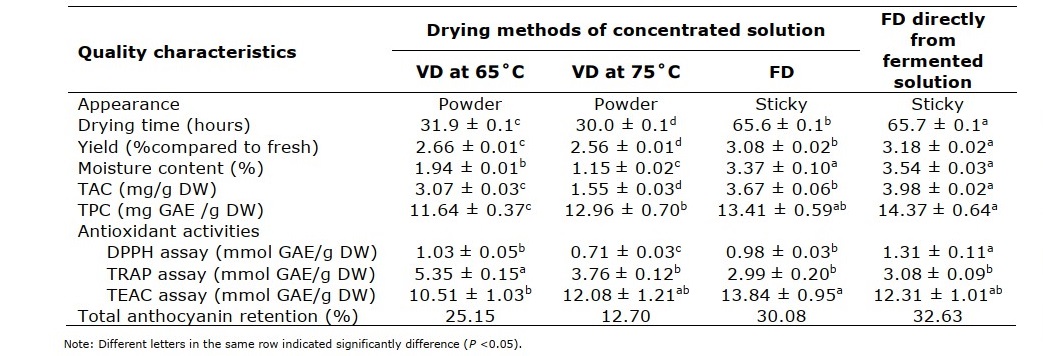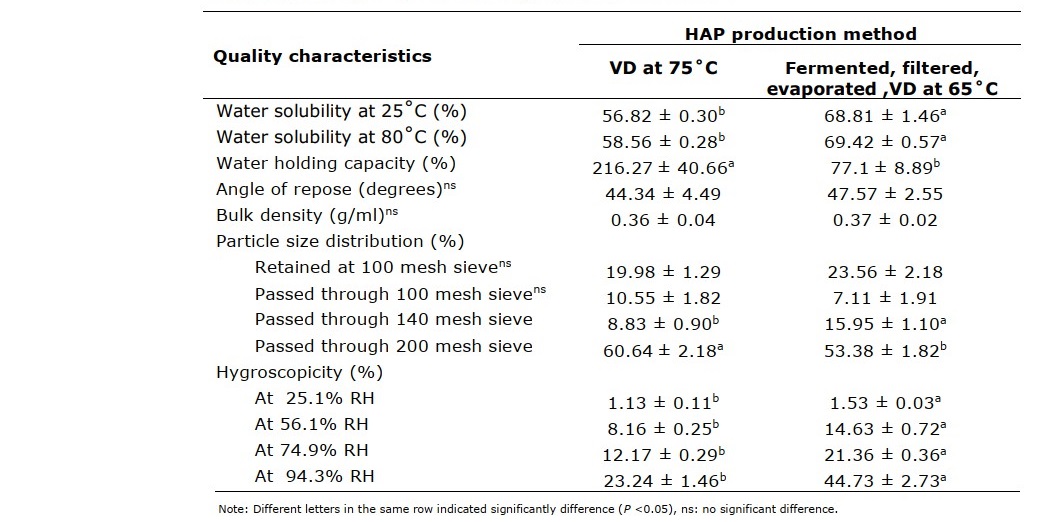
Effect of Processing Steps on Bioactive Compounds and Antioxidant Activities of High Anthocyanin Mulberry Fruit Powder
Fuangfah Punthi and Somchai Jomduang*Published Date : 2021-04-01
DOI : https://doi.org/10.12982/CMUJNS.2021.043
Journal Issues : Number 2, April-June 2021
Abstract The objective of this research was to determine the amounts of bioactive compounds and antioxidant activities in each processing step in the production of high anthocyanin powder (HAP) from mulberry fruits to investigate suitable processing methods. For fresh mulberry fruits derived of Chiang Mai varieties, both in-season and off-season fruits had similar amounts of total anthocyanin content (TAC) and total phenolic compounds (TPC). In-season mulberry fruits had the highest potential to be used as a raw material for further study because of high antioxidant activities, large fruit size, and high productivity. Two methods of HAP production were tested. The first method used whole fruit drying with different drying methods included hot air drying (HAD), vacuum drying (VD), and freeze drying (FD). Hot air drying at 50, 60 and 70°C showed a decreased concentration of anthocyanins, which were 60% lower than that of fresh fruits. Vacuum drying at 55 and 75°C could provide high anthocyanin content and was similar to freeze drying, which had 87–97% anthocyanin retention. Vacuum drying at 75°C was most suitable for HAP production because of the short drying time (22.3 ± 0.4 hours), high anthocyanin retention (87.21%), high phenolic compound content, and high antioxidant activities. The second method used fermented and concentrated mulberry juice. This process used the following steps: yeast fermentation to decrease the sugar content, filtration to get rid of solid parts, evaporation to concentrate the solution, drying with different drying methods (vacuum drying and freeze drying), and crushing to powder. Throughout fermentation, filtration, and evaporation, high phenolic compound content and antioxidant activities were observed and 77.29% of anthocyanins were retained. However, these values decreased dramatically after the drying step. Therefore, drying the concentrated solution was not effective for HAP production. Of the processing methods tested, directly drying whole mulberry fruits with VD at 75°C was most suitable for HAP production. This method provided 13.06% ± 0.35 production yield of HAP, contained 13.51±0.08 mg/g DW of total anthocyanins, and 27.47 ± 0.50 mg GAE/g DW of total phenolic compounds. Additionally, the antioxidant activities by DPPH, TRAP, and TEAC assays were 2.91 ± 0.19, 16.22 ± 0.31, and 22.34 ± 0.29 mmol GAE/g DW, respectively.
Keywords: Anthocyanins, Antioxidant activities, Bioactive compounds, Mulberry fruits, Powder
Funding: This research was supported by The Queen Sirikit Department of Sericulture.
Citation: Punthi, F. and Jomduang, S. 2021. Effect of processing steps on bioactive compounds and antioxidant activities of high anthocyanin mulberry fruit powder. CMUJ. Nat. Sci. 20(2): e2021043.
INTRODUCTION
Bioactive compounds are phytochemicals found in plant and animal-based food products that can provide desirable health benefits. Anthocyanins are one of the most important bioactive compounds. They are blue, red, or purple natural soluble pigments commonly found in plants and fruits, such as grapes, purple cabbage, butterfly peas, and berries, including mulberries and blueberries, among others. Anthocyanins are well- known for being rich in antioxidants and for their protection against cardiovascular diseases and cancer (Zhao et al., 2004). Anthocyanins are quite sensitive to heat treatment, light, and oxygen. Mulberry (Morus spp.) is commonly cultivated in Thailand. In 2012, about 94,000 Thai farmers planted mulberry and used mulberry leaf for silk yarn and silk cloth production (Wongsamuth, 2013). In Thailand, Chiang Mai varieties were developed to be fruit producing mulberry trees. Numerous studies have reported that ripe mulberry fruits contain high concentrations of anthocyanin and have antioxidant activities (Aramwit et al., 2010; Panprom, 2011; Chen et al., 2016). Fresh mulberry fruit consumption has several health benefits, including anti-cholesterol and anti-obesity components (Zhang et al., 2018) and a lower risk for coronary heart disease, cancer (Lazze et al., 2004) and Alzheimer’s disease (Shih et al., 2010).
After fruit harvesting and transportation, mulberries rot easily because they have thin skin and a soft texture. Normally, they can keep at room temperature for 1–2 days. However, mulberry fruit harvesting occurs within 1–2 weeks. Although mulberry can be controlled to grow fruit out of season, these fruits are small in size and not many are produced. Therefore, fresh mulberry fruit consumption is limited. Alternatively, mulberry fruit processing can maintain a high anthocyanin content and has a low storage cost. There are several methods used to process mulberries, which can affect the anthocyanin content. In this research, mulberry fruits were processed to high anthocyanin powder (HAP) using two methods, whole fruit drying and whole fruit fermentation, followed by filtration, evaporation, and drying. At each step of processing, bioactive compounds and antioxidant activities were analyzed. This research determined a suitable method for processing mulberries to maintain high bioactive compounds and antioxidant activities with minimal production steps for further commercial production.
MATERIALS AND METHODS
Effect of harvesting period on ripe mulberry fruit quality
Ripe (whole black fruits) fresh mulberry fruits of Chiang Mai varieties, were harvested from Baan Suan Punya Farm at San Pa Tong district, Chiang Mai province, Thailand. They were harvested at different harvesting periods: in-season (February) and off-season (August and November). They were washed with water containing 0.1% sodium metabisulfite and 0.1% citric acid (Panprom, 2011). After washing, they were blended together using a fruit blender. This experiment was designed using complete randomized design (CRD). Color values were measured by a Chroma meter (Konica Minolta, Chiyoda, Japan) using the CIE scale (L*, a*, and b*). Moisture content was measured by a moisture analyzer balance (Precisa XM-60, Switzerland). Total soluble solid (TSS) was measured by a handheld refractometer (Atago N-1E, Japan). Total anthocyanin content (TAC) was determined using a pH differential absorbance method with ethanolic HCl extracted samples (Rangnna, 2007; Laokuldilok and Kanha, 2015). Total phenolic content (TPC) were determined using Wang et al. (2019) method. Antioxidant activities were determined using three methods, including a DPPH radical scavenging activities assay (Liu et al., 2014), the total radical trapping method (Moreira et al., 2012), and Trolox equivalents antioxidant capacity (Re et al., 1999). All quality assessments were performed in triplicate and presented as the mean ± standard deviation (SD). The data were subjected to statistical analysis using SPSS statistic software version 17 (Chicago, Illinois, USA) for one-way analysis of variance (ANOVA). Duncan's new multiple range test was used to consider significant differences between treatments (P <0.05).
Effect of hot air drying (HAD), vacuum drying (VD), and freeze drying (FD) on HAP quality.
Ripe mulberry fruits were divided to dry at different temperatures using a hot air drying (HAD) technique (Memmert, Modell 600, Germany) at 50, 60 and 70˚C until less than 10% moisture content remained. Additionally, ripe mulberry fruits were divided to dry using vacuum drying (VD) and freeze drying (FD) with three treatments including VD at 55°C, VD at 75°C, and FD. Each dried sample was then ground into powder using a blender (FNB, RRHP-500A, Thailand) and sieved through 100-size mesh to HAP. This study used a complete randomized design (CRD). Color values, moisture content, TAC, TPC and antioxidant activities of powder from each drying temperature were determined. In addition, total anthocyanin retention was calculated using a comparison with ripe mulberry fruits. Water activities (aw) was determined using an AquaLab4 (Meter Group, Washington, USA). All data were evaluated using one-way ANOVA to detect treatment effects. The drying method which could retain the highest bioactive compound concentration and highest antioxidant activities was selected.
Effect of fermentation, filtration, evaporation, and drying methods on HAP quality
Effect of yeast fermentation on mulberry fruit juice quality. Ripe mulberry fruits were washed before crushing. Potassium metabisulfite (300 ppm), diammonium phosphate (300 ppm), enzyme pectinase (2,000 ppm), and enzyme cellulose (2,000 ppm) were added during crushing. The yeast (Saccharomyces cerevisiae) starter was prepared by using a 1:1 ratio of mulberry fruit juice and water, 18°Brix adjusting using sugar. After 1 day of fermentation, the yeast starter was used to inoculate a crushed mulberry fruit container. Yeast fermentation was performed at room temperature in the dark until fermentation was finished. Fermented juice was separated using a hydraulic press machine (Sakaya•I2, Thailand) and filter cloths. The fermented juice was subjected to HAP quality testing, described above, to determine mulberry fruit quality. In addition, a sugar profile was constructed using high-performance liquid chromatography (HPLC). The qualities of fermented mulberry juice were compared to that of fresh mulberry fruits.
Effect of evaporation on fermented mulberry juice quality. Fermented mulberry juice, obtained from the previous study, was 5 times concentrated using a rotary evaporator (BÜCHI, R-3, Switzerland) at 75˚C. After concentration, the sample was tested for HAP quality, as described above and compared to the fermented mulberry juice.
Effect of concentrated solution drying method on HAP quality. Concentrated mulberry juice obtained from the previous study was dried with three different drying methods, including VD at 65°C, VD at 75°C, and FD. Each dried sample was ground and sieved. Powder qualities were determined using the HAP quality tests described above. These quality test results were compared to those of obtained from fermented solution that was directly FD. The drying method that retained the highest bioactive compound concentration and highest antioxidant activities was selected for further study.
Comparison of HAP qualities from two high potential methods
Ripe mulberry fruits were processed into powder following the two selected potential methods (whole fruit drying method and whole fruit fermentation, filtration, evaporation, and drying method). Both HAP products were tested for quality and compared. Water solubility determination was adapted from a method by Hussin et al. (2017). Water holding capacity was evaluated following methods by Song et al. (2018). Angle of repose and bulk density were measured using a modified method by Plumley et al. (2009). Particle size distribution was evaluated using a sieve shaker (Endecotts Octagon 200) including 100, 140, and 200 mesh sieves. Hygroscopicity was determined according to Arigo et al. (2019). All data were evaluated using a one-way ANOVA and Duncan's new multiple range test to identify significant differences between treatments (P <0.05). The process that could had a high yield production, high anthocyanin retention, and low hygroscopicity was selected.
RESULTS AND DISCUSSIONS
Ripe mulberry fruit quality at different harvesting periods
Ripe mulberry fruits harvested in-season (February) had a darker color (lower L* value), higher moisture content, higher TSS, and lower TA than off-season fruits (Table 1). In-season and off-season fruits had similar amounts of TAC and TPC. Antioxidant activities, measured in DPPH and TRAP assays, were higher in in-season fruits than off-season fruits. In addition, in-season fruits were bigger in size and had higher productivity than off-season fruits. Overall, in-season mulberry fruits had a high potential for use as a raw material for HAP production.
Table 1. Quality of ripe mulberry fruits from different harvesting periods.

Effect of different drying methods on whole mulberry fruits
Effect of HAD temperature on HAP quality. Mulberry fruits harvested during off- season 1 (Table 1) were used in this study. HAD at different temperatures had no significant effect on yield (P >0.05) (Table 2). The color of powder was slightly different depending on drying temperature. Moisture content ranged from 3.73% to 5.58%. Aw values were slightly different between temperatures, with the powder always less than an aw of 0.6. This revealed that the powders could be stored at room temperature without the growth of microorganisms and fungi (Syamaladevi et al., 2016). TAC and TPC were similar and not significantly different (P >0.05) at the different drying temperatures. However, there was a significant effect of temperature on antioxidant activities (P <0.05). At 70˚C drying, the drying period took nearly one day (23.9 ± 1.3 hours) and total anthocyanin retention was less than 50% (Table 2). We determined that 70˚C was not a suitable drying temperature for mulberry fruit drying.
Effect of VD and FD on HAP quality. Mulberry fruits harvested during off-season 2 (Table 1) were to test the effect of VD and FD on HAP quality. There was no significant difference in yield production, color value, TAC, or TPC between VD at 55˚C, VD at 75˚C, and FD (P >0.05) All samples had an aw less than 0.6. Antioxidant activities were significantly different among drying treatments (P <0.05) (Table 3). FD had the highest total anthocyanin retention (97.41%), but it took almost two days for drying (42.0 ± 2.3 hours). VD at 75˚C had 87.21% total anthocyanin retention and took the shortest drying time (22.3 ± 0.4 hours) (Table 3). VD at 75˚C had the highest potential for drying whole mulberry fruits for HAP production.
Table 2. HAP quality from whole mulberry fruit drying at different HAD temperatures.

Table 3. HAP quality from whole mulberry fruit drying at different HAD temperatures.

Effect of fermentation, filtration, evaporation, and drying methods on HAP quality
Effect of fermentation on mulberry fruit juice quality. Mulberry fruits harvested during the in-season (Table 1) contained 4.70 ± 1.08 g/100g FW of total sugar, which consisted of 2.23 ± 0.57 g/100g fructose and 2.47 ± 0.53 g/100g glucose (Table 4). After being fermented with yeast for 3 weeks and filtered, TSS was reduced by half, but no fructose or glucose remained in the fermented solution, indicating that other soluble solids were present. TPC was increased after fermentation. Similarly, Hur et al. (2014) reported that fermentation caused fruit cell degradation, which increased polyphenol extraction. TAC and antioxidant activities were slightly decreased, but anthocyanin content remained 85.75% of that of fresh fruits. The oxygen exposure and long duration of fermentation may have caused these slight reductions.
Effect of evaporation on fermented mulberry juice quality. Concentrated fermented mulberry juice, which was obtained from 5 times concentrated fermented solution, had a 14% decrease in moisture content. TSS and TA were 4 times and 3 times higher, respectively, in the concentrated solution than in the fermented solution (Table 4). Bioactive compounds and antioxidant activities were slightly decreased because of the short evaporation time (1 hour/ concentration the 1.5 liter of fermented solution). The concentrated solution still had a high total anthocyanin content (77.29%).
Table 4. Quality of fermented mulberry juice and concentrated fermented mulberry juice compared to fresh mulberry fruits.

Effect of drying method of concentrated solution on HAP quality. All dried product obtained from FD had higher retention of anthocyanins, higher TPC, and production yield than both VD methods (Table 5). Conversely, FD dried products were sticky and could not be ground into powder. Additionally, the drying time took up to 66 hours. Therefore, FD was not suitable for HAP production. The dried product obtained from VD at 65˚C had a slightly lower retention of anthocyanins (25.15%). It also had low antioxidant activities and production yield, but it could be ground into powder and had a shorter drying time (31.9 ± 0.1 hours) (Table 5). Therefore, VD at 65˚C was selected as a potential method for drying the concentrated fermented mulberry juice for HAP production.
Table 5. Different drying methods for concentrated solution on HAP qualities.

Comparison of HAP quality from two high potential methods.
HAP obtained from the two selected potential methods (VD at 75˚C and VD at 65˚C for concentrated solution) were not significantly different (P >0.05) in angle of repose and bulk density (Table 6). HAP obtained from VD at 75˚C had smaller particles which could be more easily passed through the 140 and 200 mesh sieves. HAP obtained from VD at 65˚C with the concentrated solution presented a higher water solubility and lower water holding capacity (P <0.05), possibly because no fiber was present to influence the water holding ability (Eastwood et al., 1983). This treatment had higher moisture absorption (high hygroscopicity) and became sticky after stored in sealed aluminum foil bags for a week. In addition, it provided low production yield and retained a low concentration of bioactive compounds and antioxidant activities. Only 25.15% of anthocyanins remained (Table 5), which was almost 4 times lower compared to the HAP obtained from VD at 75˚C (87.21%) (Table 3). Lower anthocyanin content may be due to the loss of content that occurred in each processing step. Therefore, the most suitable HAP processing procedure was to directly dry whole mulberry fruits with VD at 75˚C.
Table 6. HAP quality from two high potential methods.

CONCLUSION
In-season mulberry fruits had high potential to be used as a raw material for HAP production. Whole fruit VD at 75˚C was the most suitable HAP processing method that could be used for commercial application. It could provide high production yield (13.06%), short drying time (22.3 ± 0.04 hours), high total anthocyanin retention (87.21%), high total phenolic compounds (27.47 ± 0.50 mg GAE/g DW), high antioxidant activities (DPPH, TRAP, and TEAC assays were 2.91 ± 0.19, 16.22 ± 0.31 and 22.34 ± 0.29 mmol GAE/g DW, respectively), and non-hygroscopic appearance.
ACKNOWLEDGEMENTS
The authors would like to thank Baan Suan Punya Farm for providing the mulberry fruits used in this study and the Faculty of Agro-industry, Chiang Mai University, Thailand for providing the instruments and facilities.
REFERENCES
AOAC. 2000. Official methods of analysis (17th ed.). Association of Official Analytical Chemists.
Aramwit, P., Bang, N., and Srichana, T. 2010. The properties and stability of anthocyanins in mulberry fruits. Food Research International. 43: 1093–1097.
Arigo, A., Jawahar, N., Nikhitha, K., and Jubie, S. 2019. Effect of hygroscopicity on pharmaceutical ingredients, methods to determine and overcome: an overview. Journal of Pharmaceutical Sciences and Research 11: 6–10.
Chen, H., Chen, J., Yang, H., Chen, W., Gao, H., and Lu, W. 2016. Variation in total anthocyanin, phenolic contents, antioxidant enzyme and antioxidant capacity among different mulberry (Morus sp.) cultivars in China. Scientia Horticulturae. 213: 186–192.
Eastwood, M.A., Robertson, J.A., Brydon, W.G., and MacDonald, D. 1983. Measurement of water-holding properties of fibre and their faecal bulking ability in man. British Journal of Nutrition. 50: 539–547.
Hur, S. J., Lee, S.Y., Kim, Y.C., Choi, I., and Kim, G.B. 2014. Effect of fermentation on the antioxidant activities in plant-based foods. Food Chemistry. 160: 346–356.
Hussin, A.S.M., Wan, C.W.N.S.C., Anzian, A., and Ramli, H.B. 2017. Aqueous extraction, purification and characterization of galactomannans from aren sugar palm (Arenga pinnata) fruits. International Journal on Advanced Science, Engineering and Information Technology. 7: 1148–1154.
Laokuldilok, T. and Kanha, N. 2015. Effects of processing conditions on powder properties of black glutinous rice (Oryza sativa L.) bran anthocyanins produced by spray drying and freeze drying. LWT-Food Science and Technology. 64: 405– 411.
Lazzè, M.C., Savio, M., Pizzala, R., Cazzalini, O., Perucca, P., Scovassi, A.I., and Bianchi, L. 2004. Anthocyanins induce cell cycle perturbations and apoptosis in different human cell lines. Carcinogenesis. 25: 1427–1433.
Liu, C., Chen, C., Ma, H., Yuan, E., and Li, Q. 2014. Characterization and DPPH radical scavenging activities of gallic acid-lecithin complex. Tropical Journal of Pharmaceutical Research. 13: 1333–1338.
Moreira, F.T., Guerreiro, J.R., Barros, R., and Sales, M.G.F. 2012. The effect of method, standard and sample components on the total antioxidant capacity of commercial waters assessed by optical conventional assays. Food chemistry, 134: 564–571.
Panprom, S. 2011. Ripe mulberry fruit storage using integrated methods. (Master's thesis) Faculty of Agro-Industry, Chaing Mai University.
Plumley, C., Gorman, E.M., El-Gendy, N., Bybee, C.R., Munson, E.J., and Berkland, C. 2009. Nifedipine nanoparticle agglomeration as a dry powder aerosol formulation strategy. International Journal of Pharmaceutics, 369(1–2), 136–143.
Rangnna, S. (2007). Handbook of analysis and quality control for fruits and vegetable products. Tata Mcgraw-Hill.
Re, R., Pellegrini, N., Proteggente, A., Pannala, A., Yang, M., and Rice-Evans, C. 1999. Antioxidant activities applying an improved ABTS radical cation decolorization assay. Free Radical Biology and Medicine. 26: 1231–1237.
Shih, P.H., Chan, Y.C., Liao, J.W., Wang, M.F., and Yen, G.C. 2010. Antioxidant and cognitive promotion effects of anthocyanin-rich mulberry (Morus atropurpurea L.) on senescence-accelerated mice and prevention of Alzheimer's disease. The Journal of Nutritional Biochemistry. 21: 598–605.
Song, Y., Su, W., and Mu, Y.C. 2018. Modification of bamboo shoot dietary fiber by extrusion-cellulase technology and its properties. International Journal of Food Properties. 21: 1219–1232.
Syamaladevi, R.M., Tang, J., Villa‐Rojas, R., Sablani, S., Carter, B., and Campbell, G. 2016. Influence of water activities on thermal resistance of microorganisms in low‐moisture foods: a review. Comprehensive Reviews in Food Science and Food Safety. 15: 353–370.
Wang, J., Wang, J., Ye, J., Vanga, S.K., and Raghavan, V. 2019. Influence of high- intensity ultrasound on bioactive compounds of strawberry juice: Profiles of ascorbic acid, phenolics, antioxidant activities and microstructure. Food Control. 96: 128–136.
Wongsamuth, N. 2013. Soaring silk prices lead to surge in number of farms. Retrived March, 2019, from https://www.bangkokpost.com/business/348726/soaring- silk-prices-lead-to-surge-in-number-of-farmers.html
Zhang, H., Ma, Z., Luo, X., and Li, X. 2018. Effects of mulberry fruit (Morus alba L.) consumption on health outcomes: A mini-review. Antioxidants, 7(5), 69.
Zhao, C., Amadio, P.C., Paillard, P., Tanaka, T., Zobitz, M.E., Larson, D.R., and An, K.N. 2004. Digital resistance and tendon strength during the first week after flexor digitorum profundus tendon repair in a canine model in vivo. Journal of Bone and Joint Surgery. 86: 320-327.
OPEN access freely available online
Chiang Mai University Journal of Natural Sciences [ISSN 16851994]
Chiang Mai University, Thailand https://cmuj.cmu.ac.th
Fuangfah Punthi and Somchai Jomduang*
Department of Food Science and Technology, Faculty of Agro-Industry, Chiang Mai University, Chiang Mai 50100, Thailand
Corresponding author: Somchai Jomduang, E-mail: somchai.j@cmu.ac.th
Total Article Views
Editor: Wasu Pathom-aree,
Chiang Mai University, Thailand
Article history:
Received: May 12, 2020;
Revised: July 1, 2020;
Accepted: October 12, 2020

